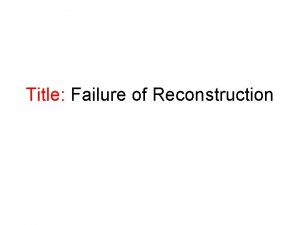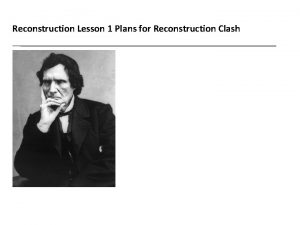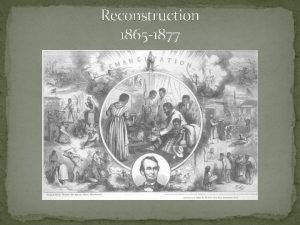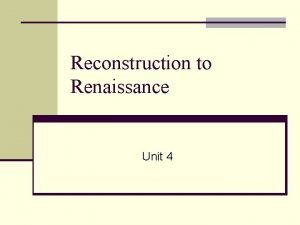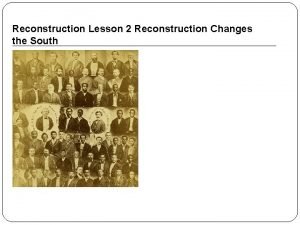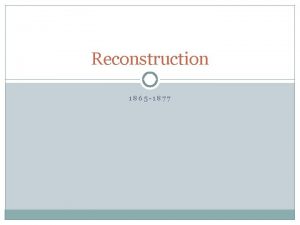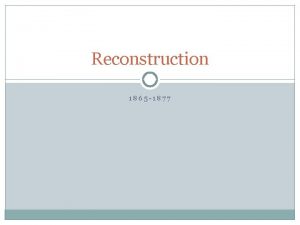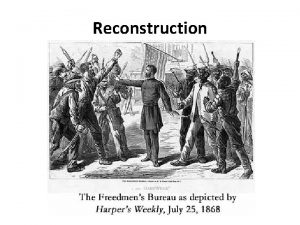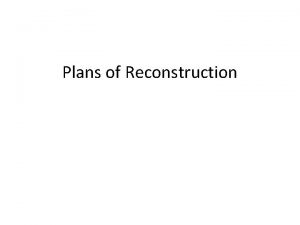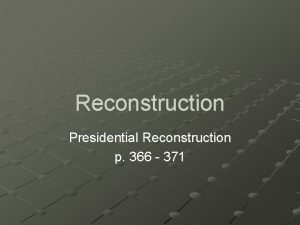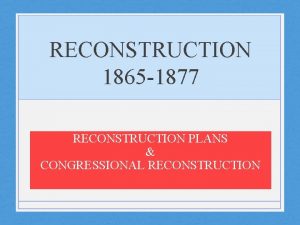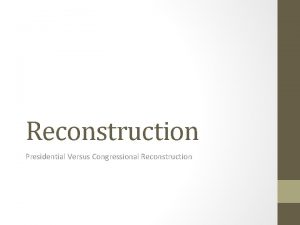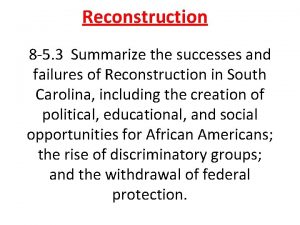Do Now Identify the successes of Reconstruction Economically

















![Northern Support Wanes « “Grantism” & corruption. « Panic of 1873 [6 -year depression]. Northern Support Wanes « “Grantism” & corruption. « Panic of 1873 [6 -year depression].](https://slidetodoc.com/presentation_image_h/23ef5feff86d1f68b5e53fc70c7b2c08/image-18.jpg)












- Slides: 30

Do Now • Identify the successes of Reconstruction: – Economically – Politically – Socially

The Fall of Reconstruction-The Compromise of 1877 and Waning Northern Support Mr. Winchell APUSH Period 5

Key Concepts • 5. 3: The Union victory in the Civil War & the contested reconstruction of the South settled the issues of slavery & secession, but left unresolved many questions about the power of the federal govt. and citizenship rights. – II: Reconstruction and the Civil War ended slavery, altered relationships between the states and the federal government, and led to debates over new definitions of citizenship, particularly regarding the rights of African Americans, women, and other minorities.

AP Prompt • Evaluate the extent to which economic factors led to the downfall of Reconstruction.

The Problems of Peacemaking • The Aftermath of War and Emancipation – The war is over, now what? – South was destroyed • Physically • Socially (20% of white male pop. ) • Economically – hyperinflation, no resources, no trade, no workers, no banks, etc. – The “Lost Cause” = sense of loss for southern whites

– 4 million slaves freed into far worse conditions? • • No family, no $, no land, no donkeys? , no where to go, no food, … you get the picture! Competing Notions of Freedom – Reconstruction = quest for freedom!!! – Blacks = land “If I cannot live like a white man, than I am not free” – Whites = freedom from “foreign” (federal) “oppression & white supremacy – whites often times tried to keep black workers legally tied to plantations, aka sharecropping

An Unreconstructed Southerner

Outline • • • Johnson’s Impeachment Grant’s Presidency Successes and Failures of Reconstruction Election of 1876/Compromise of 1877 Plessy v. Ferguson

Reconstruction Acts of 1867 « Command of the Army Act * The President must issue all Reconstruction orders through the commander of the military. « Tenure of Office Act * The President could not remove any officials [esp. Cabinet members] without the Senate’s consent, if the position originally required Senate approval. § Designed to protect radical members of Lincoln’s government. § A question of the constitutionality of this law. Edwin Stanton

President Johnson’s Impeachment « Johnson removed Stanton in February, 1868. « Johnson replaced generals in the field who were more sympathetic to Radical Reconstruction. « House impeaches him by massive majority « Senate hears trial, 1 vote short of removing from office.

Waving the Bloody Shirt! Republican “Southern Strategy”


1868 Presidential Election

Ulysses S. Grant’s Presidency • President Grant’s (a Republican) cabinet is corrupt and scandals break out • People move away from Republican party as a result • Grant thought of as one of worst Presidents

Grant Administration Scandals « Grant presided over an era of unprecedented growth and corruption. * Credit Mobilier Scandal. * Whiskey Ring. * The “Indian Ring. ”

Panic of 1873 • US economy goes into a severe recession (2 million unemployed of 36 million) – Cause: Civil War currency & overextension of industry • NO DIFFERENT THAN EVERY OTHER PANIC • People increasingly choose Democrats to try to fix the problems

Legal Challenges to Reconstruction • Civil Rights Act of 1875: – Equal access to public places – No enforcement mechanism • Slaughterhouse Cases (1873) – STRICT interpretation of 14 th Amendment – States have authority over citizens’ rights • Bradwell v. Illinois (1873) – Female attorney sues for right to practice law – SC rules she’s a woman, shouldn’t be practicing law • US v. Cruickshank (1876) – LA white supremacists accused of attacking meeting of African Americans, convicted under Enforcement Acts. – SC rules 14 th Amendment only applies to STATES discriminating, not people/business. • US v. Reese, et. Al (1876) – SC rules STATES confer voting rights on individuals, not fed. gov. – 15 th Amendment doesn’t guarantee right to vote apparently
![Northern Support Wanes Grantism corruption Panic of 1873 6 year depression Northern Support Wanes « “Grantism” & corruption. « Panic of 1873 [6 -year depression].](https://slidetodoc.com/presentation_image_h/23ef5feff86d1f68b5e53fc70c7b2c08/image-18.jpg)
Northern Support Wanes « “Grantism” & corruption. « Panic of 1873 [6 -year depression]. « Concern over westward expansion and Indian wars. « Key monetary issues: * should the government retire $432 m worth of “greenbacks” issued during the Civil War. * should war bonds be paid back in specie or greenbacks.

The Election of 1876 • Republicans nominate Rutherford B. Hayes • Democrats nominate Samuel J. Tilden • Votes contested in LA, FL, SC • Special electoral commission created to decide who gets disputed votes – Votes 8 -7 to give all electoral votes to Hayes – Democrats threaten to filibuster the results, send election to the House


U. S. Troops Recalled • Hayes wins support of the House in exchange for removing federal troops from South • Army that Congress sent to South to supervise Reconstruction were called back in 1877 by President Rutherford B. Hayes • Effectively ends supervision in the South • Southern Democrats (segregationists) are now in control

End of Reconstruction • Why did it end? – Compromise of 1877 • The compromise settled the disputed 1876 election – Hayes (Republican) became President – ENDED MILITARY RULE IN THE SOUTH! – Southerner appointed to cabinet • Impact of end of Reconstruction? – Jim Crow Laws • Upheld by Plessy v. Ferguson – Disenfranchisement for blacks

• The Southern States “Redeemed” – States of the upper south had a majority of white citizens, thus had an easy time putting their candidates into power once they regained suffrage – In states where blacks had the majority, whites used intimidation and violence to undermine the Reconstruction regimes • • KKK – secret society, midnight raids, military force; thought of as a patriotic society by southern whites Knights of the White Camellia Red Shirts and White Leagues worked to force all whites to join Democratic party and exclude blacks from political activities economic intimidation = land owners did not rent to blacks who voted

• The Birth of Jim Crow – Evading the 15 th Amendment • • • poll tax “literacy” or “understanding” tests (often unfair) grandfather laws – Williams v. Mississippi (1890) validated southern literacy tests – Jim Crow = an elaborate system of segregation reaching into almost every area of southern life. Served as a means for whites to retain control of social relations between the races in the newly growing cities and towns of the South.

• The Birth of Jim Crow – 1890 s dramatic increase in white violence towards blacks: 187 lynchings each year, more than 80% of them in the South, the vast majority of victims black – prisoners seized from within prisons and hanged in front of large audiences – Southern whites controlled black population through terror

The New South • The “Redeemers” – – – by 1877 every southern state “redeemed” = white Democrats in charge at nearly every level of Southern government South falls into control of a powerful, conservative oligarchy known as “Redeemers” or “Bourbons” Committed to home rule, social conservatism and economic development Democrats cut taxes, reduced government spending, drastically diminished state services Dissenting movements (“Readjusters”, etc. ) crushed

• The Industrialization of the “New South” – – – – Many Southerners believed they had lost the war because they had a weak industrial economy. . . now the goal of the “New South was to Out Yankee the Yankees” Southern literature and print depicted antebellum South with nostalgia and embraced the “Lost Cause”. . . portrayed slaves society as a harmonious world Textile factories appearing in greater numbers in the South Iron and the Railroad Women working in them, African Americans barred Efforts to unionize crushed Prisoners, “chain gangs”, often doing hard labor and being paid nothing

The “New South” • Henry W. Grady – "There was a South of slavery and secession - that South is dead. There is now a South of union and freedomthat South, thank God, is living, breathing, and growing every hour, ” (1886) – "the supremacy of the white race of the South must be maintained forever, and the domination of the negro race resisted at all points and at all hazards, because the white race is the superior race. . . [This declaration] shall run forever with the blood that feeds Anglo-Saxon hearts. ” (1888) • • Public School Systems Agriculture – Cotton, tobacco, rice • Industry and Urbanization – Dependent on Northern investment – Increased network of standardized rail lines – Coal mining

Four Reasons For End of Reconstruction 1) 2) 3) 4) Legal challenges to Reconstruction Grant’s Presidency (he sucks) Panic of 1873 Recall of troops in 1877/Compromise of 1877

Evolution of Northern Attitude Toward Blacks During Reconstruction Shown through the political cartoons of Thomas Nast of Harper’s Weekly “And Not This Man? ” August 1865 “Colored Rule in a Reconstructed State” March 1874
 Successes of reconstruction
Successes of reconstruction Joseph stalin main accomplishments
Joseph stalin main accomplishments John cabot successes
John cabot successes Economically speaking
Economically speaking Now i see it now you don't
Now i see it now you don't Thơ thất ngôn tứ tuyệt đường luật
Thơ thất ngôn tứ tuyệt đường luật Từ ngữ thể hiện lòng nhân hậu
Từ ngữ thể hiện lòng nhân hậu Sự nuôi và dạy con của hươu
Sự nuôi và dạy con của hươu Thế nào là hệ số cao nhất
Thế nào là hệ số cao nhất Diễn thế sinh thái là
Diễn thế sinh thái là Vẽ hình chiếu vuông góc của vật thể sau
Vẽ hình chiếu vuông góc của vật thể sau Frameset trong html5
Frameset trong html5 101012 bằng
101012 bằng Lời thề hippocrates
Lời thề hippocrates Tư thế worm breton
Tư thế worm breton đại từ thay thế
đại từ thay thế Vẽ hình chiếu đứng bằng cạnh của vật thể
Vẽ hình chiếu đứng bằng cạnh của vật thể Quá trình desamine hóa có thể tạo ra
Quá trình desamine hóa có thể tạo ra Công thức tiính động năng
Công thức tiính động năng Thế nào là mạng điện lắp đặt kiểu nổi
Thế nào là mạng điện lắp đặt kiểu nổi Sự nuôi và dạy con của hổ
Sự nuôi và dạy con của hổ Các châu lục và đại dương trên thế giới
Các châu lục và đại dương trên thế giới Các loại đột biến cấu trúc nhiễm sắc thể
Các loại đột biến cấu trúc nhiễm sắc thể Biện pháp chống mỏi cơ
Biện pháp chống mỏi cơ Bổ thể
Bổ thể Phản ứng thế ankan
Phản ứng thế ankan Thiếu nhi thế giới liên hoan
Thiếu nhi thế giới liên hoan Hát lên người ơi
Hát lên người ơi điện thế nghỉ
điện thế nghỉ Một số thể thơ truyền thống
Một số thể thơ truyền thống Trời xanh đây là của chúng ta thể thơ
Trời xanh đây là của chúng ta thể thơ
